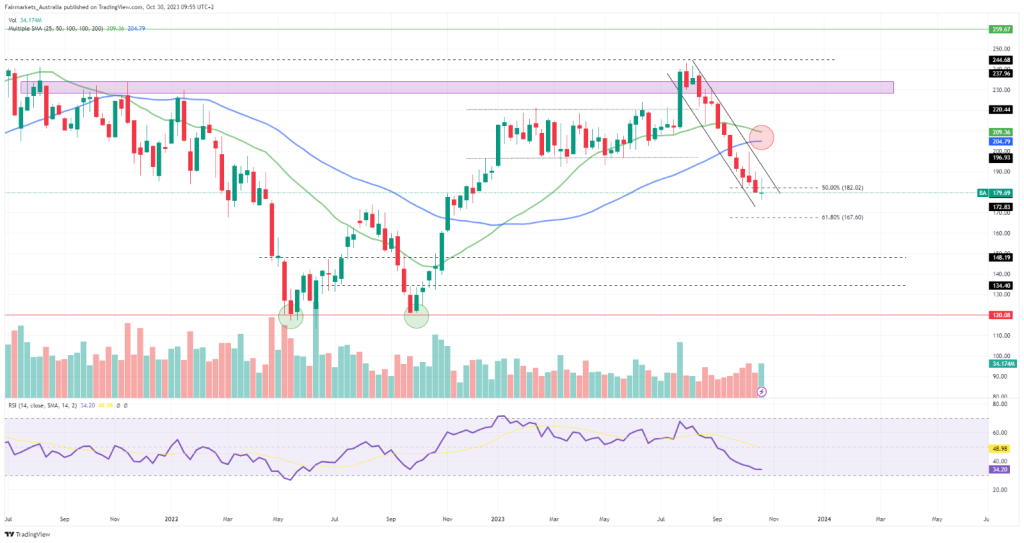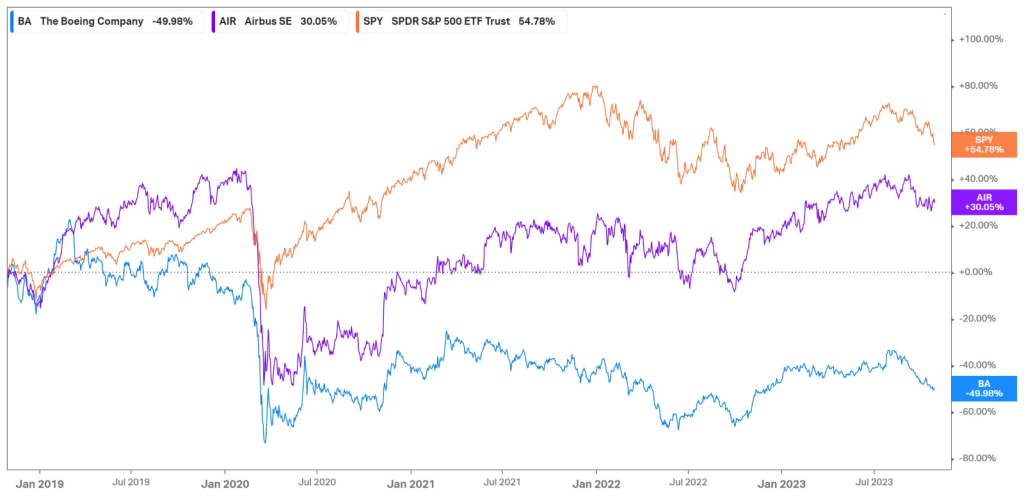
The Boeing Company (NYSE: BA), a prominent player in the aerospace and defence industry, recently revealed its third-quarter financial performance. Despite a notable upturn in demand for aircraft following the challenging times of the pandemic, the company grappled with manufacturing hurdles from Spirit AeroSystems and supply chain complexities, causing some strain on their financials.
During this quarter, Boeing’s revenue surged by an impressive 13%, reaching $18.10 billion, although it narrowly missed the consensus estimate of $18.30 billion. Simultaneously, the company made progress in reducing its bottom line loss, which decreased from $6.18 per share in the same quarter the previous year to $3.26 per share. This outcome, however, fell short of market expectations, as analysts had anticipated a more substantial improvement, with a projected loss of $2.61 per share. As a result, the company’s share price experienced a decline of over 2.5%, reflecting the market’s apprehension about Boeing’s future outlook.
Technical
On the weekly chart, the share price has recently entered a sideways consolidation in a rectangle pattern. While the breakout initially occurred to the upside, it failed to sustain, which triggered a downtrend that has seen the share price close in the red for the past ten weeks. While the 14-day RSI nears oversold condition, the recent crossing of the share price below the 50-SMA (blue line) paints a concerning picture for the momentum as we advance.
The Fibonacci midpoint from the late July peak has been broken down at $182.02, bringing the 61.8% golden ratio into the equation as the next level of support at $167.60. While a pivot to the upside is possible at this level, current momentum could see a sustainable breakdown occur, leading the price lower to $148.19 in the long term.
However, should the price find support at $167.60, the share price can engage in a correction of the recent downtrend, with the 50-SMA offering strong resistance to the upside at $204.79. If the price can clear this hurdle, the supply zone at $234.04 could be the final test of the uptrend’s strength before convergence with the estimated fair value at $259.67 can occur, which offers a lucrative 44% potential upside from current levels.

Fundamental
The past five years have been challenging for Boeing, which has reported losses in all but two quarters since 2019. Its entire fleet of 737 Max jets was grounded for almost two years after multiple fatal crashes forced the company to investigate several engineering faults in its aircraft, resulting in more than $25Bn in losses. In its latest quarterly report, it announced that the company once again cited a series of errors on fuselages delivered from its suppliers that have forced the company to inspect and remedy hundreds of planes in its inventory. As a result, factory space and labour were diverted away from new production, further adding to the company’s woes. These challenges have resulted in the company losing almost half of its value over the last five years, while its competitor, Airbus, has appreciated 30% over the same time. The question now lingers: Are these challenges short-term in nature, presenting a lucrative opportunity for investors at lower prices, or is this a longer-term fundamental correction, as Boeing falls behind Airbus in the industry?

Revenue for the quarter advanced by 13% to $18.1Bn, bringing the top line for the first nine months of its financial year to $55.78Bn, a 20% appreciation from the prior nine-month period. Its Commercial Airplane revenue, as shown below, is the largest revenue contributor, generating $7.88Bn in the latest quarter, up 25%. This was driven by higher 787 deliveries, but the total deliveries for the quarter fell from 112 to 105. The loss from operations in this segment widened from $622M to $678M, reflecting lower 737 deliveries, as well as a rise in abnormal costs, including research and development expenses. The Defence, Space & Security segment was, however, the biggest loss attribution for the quarter, as the company realized a $482M loss on their VC-25B program due to engineering changes and labour instability. Another $325M in losses were incurred on a satellite contract, offsetting the slight rise in revenue from $5.31Bn to $5.48Bn. The standout performer was its Global Services segment, which generated earnings of $784M, offsetting some of the losses in its other segments. Higher commercial volume and mix resulted in a 9% revenue improvement in this segment from $4.43Bn to $4.81Bn. It could be slightly concerning that the smallest revenue contributor is the only segment in the business making a profit, which reflects the current challenges faced by the company’s core businesses.

The graph below shows the company’s deliveries over the last 20-odd years, showing the company’s struggle to recover from the sharp drop in 2019 when a restriction was placed on global travel. The supply chain issues have constrained their ability to increase their deliveries sustainably, and management once again pulled back on its full-year delivery goal for 2023, reflecting a raft of quality issues in recent months. The company lowered its delivery targets for the year to 375-400 from the prior 400-500, which remains markedly lower than the 806 it managed in its 2018 peak.

However, despite the lower delivery numbers, the company still aims to hit its goal of increasing production of its 737 jets from 31 per month to 38 per month while reiterating its plan to increase output to 50 per month by 2025-2026. Similarly, it reaffirmed its guidance for operating cash flows of $4.5Bn to $6.5Bn for the year despite revealing a sharp decline from $3.19Bn to $22M in the latest quarter, which it attributed to unfavourable timing of receipts. Free cash flow is also expected to be in the range of $3Bn – $5Bn for the year despite falling from $2.91Bn to -$310M in the latest quarter.
One optimistic metric in the company’s report was its backlog, which currently sits at $469Bn, including over 5,100 commercial planes. This is up 7% from the quarter before and 23% higher than the year-ago figure, showcasing its largest backlog since 2019. This signals the strong demand for its aircraft, and while the timing of these contracts coming due is uncertain, it could be seen as a lucrative opportunity for growth if the company can improve on its current manufacturing and supply chain considerations.
Summary
After reporting another loss-generating earnings report, Boeing faces bottom-line headwinds despite strong demand for commercial aircraft. However, with a strong backlog of orders and a share price that trades low relative to historic levels, there could be a potential opportunity for the share price to converge with its estimated fair value of $259.67 in the longer term.
Sources: Koyfin, Tradingview, Statista, The Business Journals, Yahoo Finance, The Boeing Company
Piece written by Tiaan van Aswegen, Trive Financial Market Analyst
Disclaimer: Trive South Africa (Pty) Ltd, Registration number 2005/011130/07, and an Authorised Financial Services Provider in terms of the Financial Advisory and Intermediary Services Act 2002 (FSP No. 27231). Any analysis/data/opinion contained herein are for informational purposes only and should not be considered advice or a recommendation to invest in any security. The content herein was created using proprietary strategies based on parameters that may include price, time, economic events, liquidity, risk, and macro and cyclical analysis. Securities involve a degree of risk and are volatile instruments. Market and economic conditions are subject to sudden change, which may have a material impact on the outcome of financial instruments and may not be suitable for all investors. When trading or investing in securities or alternative products, the value of the product can increase or decrease meaning your investment can increase or decrease in value. Past performance is not an indication of future performance. Trive South Africa (Pty) Ltd, and its employees assume no liability for any loss or damage (direct, indirect, consequential, or inconsequential) that may be suffered from using or relying on the information contained herein. Please consider the risks involved before you trade or invest.




